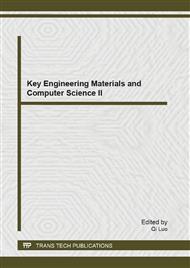[1]
Wang, Y. P.; Smith, R. Wastewater Minimization with Flowrate Constraints. Chem. Eng. Res. Des. Forum Vol. 73 (1995), P. 889–904.
Google Scholar
[2]
El-Halwagi M M, Gabriel F, Harell D. Rigorous graphical targeting for resource conservation via material recycle / reuse networks. Ind Eng Chem Res. Forum Vol. 42 (2003), P. 4319–4328.
DOI: 10.1021/ie030318a
Google Scholar
[3]
Prakash R, Shenoy UV. Targeting and design of water networks for fixed flowrate and fixed contaminant load operations. Chemical Engineering Science. Forum Vol. 60 (1) (2005), P. 255-268.
DOI: 10.1016/j.ces.2004.08.005
Google Scholar
[4]
Feng X, Seider W D. A new structure and design methodology for water networks. Ind Eng Chem Res. Forum Vol. 40 (26) (2001), P. 6140-6146.
DOI: 10.1021/ie000835i
Google Scholar
[5]
Manan ZA, Wan Alwi SR, Ujang Z. Water pinch analysis for an urban system: A case study on the Sultan Ismail Mosque at the Universiti Teknologi Malaysia (UTM). Desalination. Forum Vol. 194 (2006), P. 52–68.
DOI: 10.1016/j.desal.2005.11.003
Google Scholar
[6]
Doyle S J and Smith R. Targeting water reuse with multiple contaminants. Transactions of International Chemical Engineering. Forum Vol. 75 (B3) (1997), P. 181-189.
Google Scholar
[7]
Prakotpol D, Srinophakun T. GAPinch: Genetic algorithm toolbox for water pinch technology. Chemical Engineering and Processing. Forum Vol. 43 (2004), P. 203–217.
DOI: 10.1016/s0255-2701(03)00102-8
Google Scholar
[8]
Savelski M, Bagajewicz M. On the necessary conditions of optimality ofwater utilizations systems in process plants with multiple contaminants. Chemical Engineering Science. Forum Vol.58 (2003), P. 5349-5362.
DOI: 10.1016/j.ces.2003.09.004
Google Scholar
[9]
Ma H, Feng X and Cao K. A rule-based design methodology for water networks with internal water mains. Chemical Engineering Research and Design. 85(4) (2005), P. 431-444.
DOI: 10.1205/cherd06139
Google Scholar
[10]
Feng X, Sheng R.J.,Yu X.J. Optimization of regeneration recycling water networks with internal water mains. Journal of Chemical Industry and Engineering.Forum Vol. 59 (8) (2008), P. 2046-2051
Google Scholar
[11]
He Haina,Wan Linzhan, Liu Zhi-Yong. A simple design method for water network with multi-contaminant internal water mains. Journal of Chemical Industry and Engineering. Forum Vol. 61(5) (2010), P. 1176-1182.
Google Scholar
[12]
Savelski M, Bagajewicz M. Algorithmic procedure to design water utilization systems featuring a single contaminant in process plants. Chemical Engineering Science. Forum Vol. 56 (5) (2001), P. 1897-1911
DOI: 10.1016/s0009-2509(00)00405-x
Google Scholar
[13]
Liu Zhi-Yong, Yang Yu-Zhen, Li Yan-Mei. Targeting the freshwater for water networks with single contaminant. Computer Aided Chemical Engineering. Forum Vol.24 (2007), P. 1349-1354
DOI: 10.1016/s1570-7946(07)80249-5
Google Scholar
[14]
Bagajewicz MJ, Rivas M and Savelski MJ. A robust method to obtain optimal and sub-optimal design and retrofit solutions of water utilization systems with multiple contaminants in process plants. Computers and Chemical Engineering. Forum Vol.24 (2006), P.1461-1466.
DOI: 10.1016/s0098-1354(00)00413-0
Google Scholar
[15]
Bagajewicz M, Rivas M, Savelski M. A new approach to the design of water utilization systems with multiple contaminants in process plants. Computers and Chemical Engineering. Forum Vol. 24 (2000), P. 2093-2113.
DOI: 10.1016/s0098-1354(00)00413-0
Google Scholar
[16]
Kuo W C J, Smith R. Design of water-Using system involving regeneration. Transactions of International Chemical Engineering. Forum Vol.76 (B) (1998), P. 94-114.
Google Scholar
[17]
Hallale N. A new graphical targeting method for water minimization. Adv Environ Res. Forum Vol.6 (3) (2002), P. 377-390
Google Scholar
[18]
Detchasit Prakotpol, Thongchai Srinophakun. GAPinch: genetic algorithm toolbox for water pinch technology. Chemical Engineering and Processing. Forum Vol.43 (2004), P. 203-217
DOI: 10.1016/s0255-2701(03)00102-8
Google Scholar
[19]
Takama N, Kuriyama T, Shiroko K, et al. Optimal water allocation in a petroleum refinery. Computers and Chemical Engineering. Forum Vol.4 (1980), P. 251-258
DOI: 10.1016/0098-1354(80)85005-8
Google Scholar
[20]
Xu D M, Hua B, Hu Y D, Wang X L. Progressively unliner programming method for wastewater minimization with multiple contaminants. Computers and Chemical Engineering. Forum Vol.20 (6) (2003), P. 790-792.
Google Scholar
[21]
Zheng S Q, Zou L, Yang X. The improvement and comparation for the design of the water-using network with multiple contaminants. Computers and Chemical Engineering. Forum Vol.24 (11) (2007), P. 1497-1500.
Google Scholar
[22]
Liu Q, Guang X, Shao H. The optimal design of the water-using network with multiple contaminants—Quality analysis and mathematical programming. Journal of Chemical Industry and Engineering. Forum Vol.59 (6) (2008), P. 1441-1447.
Google Scholar
[23]
João Teles, Pedro M Castro, Augusto Q Novais. LP-based solution strategies for the optimal design of industrial water networks with multiple contaminants. Chemical Engineering Science. Forum Vol. 63 (2008), P. 376-394
DOI: 10.1016/j.ces.2007.09.033
Google Scholar
[24]
Savelski M, Bagajewicz M. On the optimality conditions of water utilization systems in process plants with single contaminants. Chemical Engineering Science. Forum Vol. 55 (2000), P. 5035-5048.
DOI: 10.1016/s0009-2509(00)00127-5
Google Scholar
[25]
Savelski M, Bagajewicz M. A new algorithmic design procedure for the design of water utilization systems in refineries and process plants. Proceedings of Press, 99 Meeting, Budapest(1999).
Google Scholar
[26]
Liu Z Y, Li Y M, Liu Z H, et al. A Simple Method for Design of water-using networks with multiple contaminant involving regeneration reuse. AIChE J. . Forum Vol.55 (6) (2009), P. 1628-1633.
DOI: 10.1002/aic.11748
Google Scholar
[27]
Pan Chun-Hui, Shi Jing. Liu Zhi-Yong. An iterative method for design of water-using networks with regeneration recycling. AIChE J. Forum Vol.58(2) (2012), P. 456-465.
DOI: 10.1002/aic.12595
Google Scholar
[28]
Pan ChunHui, Shi Jing, Liu Zhi-Yong. Design of water-Using networks of multiple contaminants by determining concentration order of streams. Journal of Chemical Industry and Engineering. Forum Vol.61(10) (2010), P. 2644-2650.
Google Scholar
[29]
Liu Z-Y, Yang Y, Wan L-Z, Wang X, Hou K-H. A heuristic design procedure for water-using networks with multiple contaminants. AIChE J. Forum Vol.55 (2009), P. 374–382.
DOI: 10.1002/aic.11693
Google Scholar


